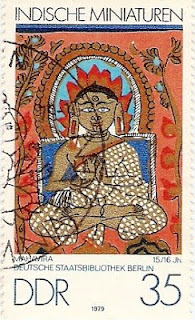On the occasion of the 2600th Janma Kalyanak (Birth Anniversary) year of the 24th Jain Thirthankara Bhagwan Mahaveer, Indian Postal Department had issued a Rs. 3/- denomination stamp on 6th April 2001. This stamp depicts the unique symbol summarizing Jain teachings of Ahimsa Paramodharma adopted with the words Parasparopagraho Jivanam by all Jain groups.
On the occasion of 2500th Nirvana Anniversary of Bhagwan Mahaveer, a stamp worth 25 paisa was issued on 13th November 1974. The stamp depicted the lake temple Jal-Mandir of Pavapuri (Bihar) where Bhagwan Mahaveer attained Nirvana, the salvation.
The first stamp on Jainism to be issued from outside India came from East Germany. On 23 August, 1979 the East German Postal Department issued a set of four stamps on Indian miniature paintings. One of these showed the beautiful painting of Lord Mahaveer from the fifteenth or sixteenth century.
Mahaveer Janma Kalyanak or Mahaver Jayanti, is one of the most important religious festival for Jains. It celebrates the birth of Mahaveer, the twenty-fourth and last Tirthankara. As per the Gregorian calendar, the holiday occurs either in March or April.
According to Jain texts, Mahaveer was born on the thirteenth day of the bright half of the moon in the month of Chaitra in the year 599 BCE (Chaitra Sud 13). Mahaveer was born in a democratic kingdom (Ganarajya), Vajji, where the king was chosen by votes. Vaishali was its capital.
Mahaveer was named 'Vardhamana', which means "One who grows", because of the increased prosperity in the kingdom at the time of his birth. In Vasokund, Mahaveer is much revered by the villagers. A place called Ahalya bhumi has not been ploughed for hundreds of years by the family that owns it, as it is considered to be the birthplace of Mahaveer.
Mahaveer was born into Ikshvaku dynasty as the son of King Siddhartha of Kundagrama and Queen Trishala. During her pregnancy, Trishala was believed to have had a number of auspicious dreams, all signifying the coming of a great soul. Digambara sect of Jainism holds that the mother saw sixteen dreams which were interpreted by the King Siddhartha. According to the Svetambara sect, the total number of auspicious dreams is fourteen. It is said that when Queen Trishala gave birth to Mahaveer, Indra, the head of heavenly beings (devas) performed a ritual called abhisheka, this being the second of five auspicious events (Panch Kalyanakas), said to occur in the life of all Tirthankaras.
The idol of Mahaveer is carried out on a chariot, in a procession called rath yatra. On the way stavans (religious rhymes) are recited. Statues of Mahaveer are given a ceremonial anointment called the abhisheka. During the day, most members of the Jain community engage in some sort of charitable act. Many devotees visit temples dedicated to Mahaveer to meditate and offer prayers. Lectures by monks and nuns are held in temples to preach the path of virtue as defined by Jainism.


